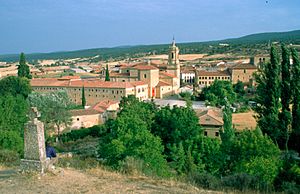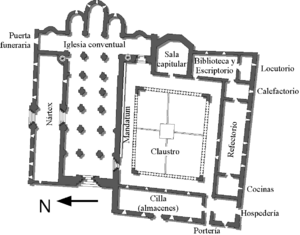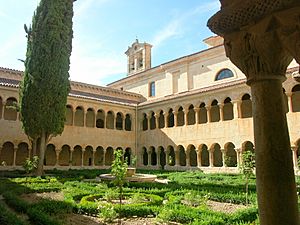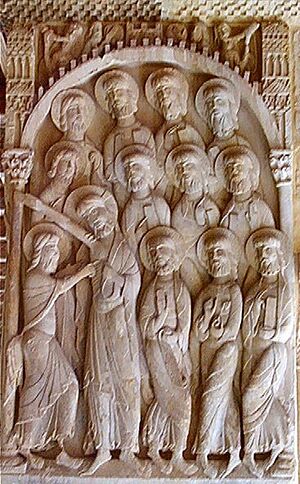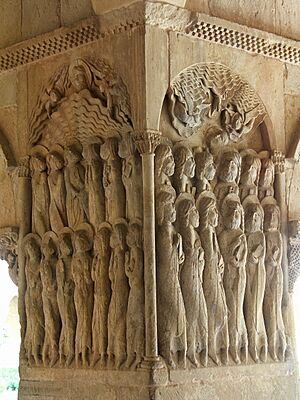Abbey of Santo Domingo de Silos facts for kids
The Santo Domingo de Silos Abbey is a famous Benedictine monastery in northern Spain. It is located in a small village called Santo Domingo de Silos in the Burgos Province. This special place is named after Dominic of Silos, a saint from the 11th century.
Contents
History of the Abbey
The Santo Domingo de Silos Abbey has a very long history. It started way back in the 7th century, during the Visigothic period. In the 10th century, it was known as San Sebastián de Silos.
How the Abbey Got Its Name
The monastery got its current name thanks to Dominic of Silos. He was asked by King Fernando the Great of Castile and León to help rebuild the abbey. Before this, Dominic was a leader at the Monasteries of San Millán de la Cogolla. He and two other monks were forced to leave by King García Sánchez III of Navarre. This happened because they disagreed with the king wanting to take over the monastery's land.
Building the Church and Cloister
Abbot Dominic planned the church to have a main hall, two side aisles, and five small chapels. When he passed away in 1073, Abbot Fortunius took over the building work. He finished the church and the cloister. Later, a new church was built by the architect Ventura Rodríguez.
In 1835, the abbey, like many other monasteries in Spain, was closed. But in 1880, Benedictine monks from France helped bring it back to life.
Amazing Romanesque Art and Architecture
The monastery's two-story cloister is a true masterpiece of Romanesque art. A cloister is an open area, usually square, surrounded by covered walkways. The cloister here has large stone carvings on its column tops, called capitals, and also on flat panels. These carvings are very famous.
Exploring the Cloister
The lower part of the cloister has capitals decorated with cool creatures like dragons, centaurs, and mermaids. You can also see a special Romanesque statue of the Madonna and Child. The cloister is the only part of the monastery that looks almost exactly as it did when it was first built. It's shaped like an angled rectangle. It has 16 arches on the north and south sides, and 14 arches on the west and east sides.
Building the lower part of the cloister began in the late 11th century and finished in the mid-12th century. We know this because of a stone carving about Saint Dominic, who died in 1073. The cloister was officially opened on September 29, 1088. The upper story of the cloister was finished during the 12th century.
Building Pauses and New Styles
Abbot Fortunius, who followed Abbot Dominic, was in charge of building the north and original west parts of the cloister. He had to stop building because so many pilgrims came to visit Saint Dominic's shrine. Also, construction stopped for several decades between 1109 and 1120 due to money and political problems. Because of this break, the west and south parts of the cloister look different. This suggests that a new group of builders was hired to finish the work.
The cloister has four square pillars at each corner. Between these pillars, there are pairs of columns that support the arches. These arches sit on a raised platform. In the middle of each side, there's a group of four columns. The tall pillars have amazing carvings of Bible stories from after Jesus's death. These include the Three Marys finding Jesus is gone, the Pentecost, Doubting Thomas, and the Road to Emmaus. These carvings were once painted in bright colors. They were made in the mid-12th century by the same artist who carved the lower column tops. This artist might have also worked on the Abbey of St. Pierre de Moissac in France.
The pillar in the southeast corner shows the Ascension and the Pentecost. The northeast pillar shows the Entombment and the Descent from the Cross. The northwest pillar shows the disciples of Emmaus. The southwest pillar shows the Annunciation to Mary and the Tree of Jesse.
Each pair of columns shares a single capital, which is the top part of the column. Every capital has a unique design, with animals, plants, or abstract patterns. The capitals on the second story of the cloister tell stories, as they were made later. The east part of the cloister was finished first, then the north. Work started again in 1158 after the break. The south part was completed soon after, and the rebuilt west part was the last. Before the west part was done, plans were made for the second story. Many people think the carvings on the lower story are even better than those on the upper story.
The Abbey Library
The Silos Library was once a very important place for old church books, along with the library at Toledo Cathedral. Many of these books were sold in 1878.
Special Manuscripts
The library still holds the Missal of Silos, which is the oldest Western manuscript written on paper. There is also a historic pharmacy with its own special library.
Silos Scriptorium: Where Books Were Made
A scriptorium is a room where monks copied and decorated books by hand. Some manuscripts from the Silos scriptorium are now kept in the British Library in London and the Bibliothèque nationale de France in Paris.
One of the most important books made at the abbey was a beautifully illustrated Beatus manuscript. This book was a commentary on the Apocalypse. The writing was finished in 1091 by two monks. But the amazing pictures were mostly added later by the prior, who finished his work in 1109. These pictures include an important map of the Mediterranean regions. This book is now in the British Library.
Music at the Abbey
The monks at Santo Domingo de Silos Abbey have a long tradition of singing. They originally sang Mozarabic chant, which is a very old style of church music. Around the 11th century, they switched to Gregorian chant.
In 1880, the abbey joined the Solesmes Congregation, a group known for its strong tradition of singing Gregorian chant. The singing at Silos has been influenced by the research and style of Solesmes Abbey.
Famous Recordings
Gregorian Chant Recordings
The monks of Silos became famous around the world for their Gregorian chant. This happened because of their very successful 1994 album called Chant. This album reached #3 on the Billboard music chart and sold millions of copies. It became the best-selling Gregorian chant album ever!
They released other albums too, like Chant Noël: Chants for the Holiday Season (also 1994) and Chant II (1995). While other choirs might be more technically perfect, the Silos monks are truly authentic. They sing Gregorian chant as part of their daily worship. As a reviewer in Gramophone magazine said, "if these are not professional singers, they are, and they sound like, truly professional monks."
Mozarabic Chant Recordings
The monks of Silos are also one of the few choirs to have recorded Mozarabic chant. They did this for a 1970 album.
Visiting the Abbey
The cloisters and the old pharmacy are open for people to visit. You can also attend church services, like vespers, in the abbey church. If you are a researcher, you might be able to get special access to the library.
|
See also
 In Spanish: Monasterio de Santo Domingo de Silos para niños
In Spanish: Monasterio de Santo Domingo de Silos para niños


